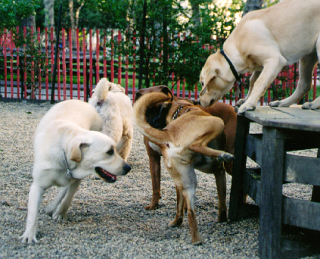Adolescent Changes

A dog's adolescence is the time when everything starts to fall apart, unless you make a concerted effort to see it through to the stability of adulthood. Your dog's adolescence is a critical time. If you ignore your dog's education now, you will soon find yourself living with an ill-mannered, under-socialized, hyperactive animal. Here are some things to watch for.
Household etiquette may deteriorate over time, especially if you start taking your dog's housetraining and other good behavior for granted. But if you taught your pup well in his earlier months, the drift in household etiquette will be slow until your dog reaches his sunset years, when housetraining especially tends to suffer.
Basic manners may take a sharp dive when puppy collides with adolescence. Lure/reward training your puppy was easy: you taught your pup to eagerly come, follow, sit, lie down, stand still, roll over, and look up to you with unwavering attention and respect because you were your pup's sun, moon, and stars. But now your dog is developing adult doggy interests, such as investigating other dogs' rear ends, sniffing urine and feces on the grass, rolling in unidentifiable smelly stuff, and chasing squirrels. Your dog's interests may quickly become distractions to training, so that your dog will continue sniffing another dog's rear end rather than come running when called. (What a scary thought, that your dog would prefer another dog's rear end to you!) All of a sudden he won't come, won't sit, won't settle down and stay, but instead jumps up, pulls on-leash, and becomes hyperactive.
Bite inhibition tends to drift as your dog gets older and develops more powerful jaws. Giving your dog ample opportunity to wrestle with other dogs, regularly handfeeding kibble and treats, and periodically examining and cleaning your dog's teeth are the best exercises to ensure that your adolescent dog maintains his soft mouth.
Socialization often heads downhill during adolescence, sometimes surprisingly precipitously. As they get older, dogs have fewer opportunities to meet unfamiliar people and dogs. Puppy classes and parties are often a thing of the past and most owners have established a set routine by the time their dog is five or six months old. At home, the dog interacts with the same familiar friends and family, and is walked, if at all, on the same route to the same dog park, where they encounter the same old people and the same old dogs. Consequently, many adolescent dogs become progressively desocialized toward unfamiliar people and dogs until eventually they become intolerant of all but a small inner circle of friends.
If your adolescent dog does not get out and about regularly and few unfamiliar people come to the house, his desocialization may be alarmingly rapid. At five months your dog was a social butterfly with nothing but wiggles and wags when greeting people, but by eight months of age he has become defensive and lacking in confidence: he barks and backs off, or he snaps and lunges with hackles raised. A previously friendly adolescent dog might suddenly and without much warning be spooked by a household guest.
Puppy socialization was a prelude to your safe and enjoyable continued socialization of your adolescent dog. However, your adolescent dog must continue meeting unfamiliar people regularly, otherwise he will progressively desocialize. Similarly, successful adolescent socialization makes it possible for you to safely and enjoyably continue to socialize your adult dog. Socialization is an on ongoing process.
Dog-Dog Socialization also deteriorates during adolescence, often at an alarming rate, especially for very small and very large dogs. First, teaching a dog to get along with every other dog is difficult. Groups of wild canids — wolves, coyotes, jackals, etc. — seldom welcome strangers into their midst, but that's exactly what we expect of Canis familiaris. Second, it is unrealistic to expect a dog to be best friends with every dog. Much like people, dogs have special friends, casual acquaintances, and individuals they don't particularly like. Third, it is quite natural for dogs (especially males) to squabble. In fact, it is a rare male dog that has never been involved in some physical altercation. Everything was fine with young pups playing in class and in parks, but with adolescent dogs, the scraps, the arguments, and even the play-fighting seem all too real.
A dog's first adolescent fight often marks the beginning of the end of his socialization with other dogs. Again, this is especially true for very small and very large dogs. Owners of small dogs are understandably concerned about their dog's safety and may be disinclined to allow their dogs to run with the big dogs. Here is where socialization starts downhill and the small dog becomes increasingly snappy and scrappy. Similarly, owners of large dogs (especially the working breeds) are understandably concerned that their dogs might hurt smaller dogs. Here too socialization goes downhill and the big dog becomes increasingly snappy and scrappy. Now we're in vicious circle: the less the dog is socialized, the more likely he is to fight and thus be less socialized.
Adapted from AFTER You Get Your Puppy by Dr. Ian Dunbar